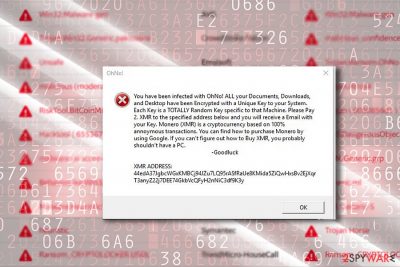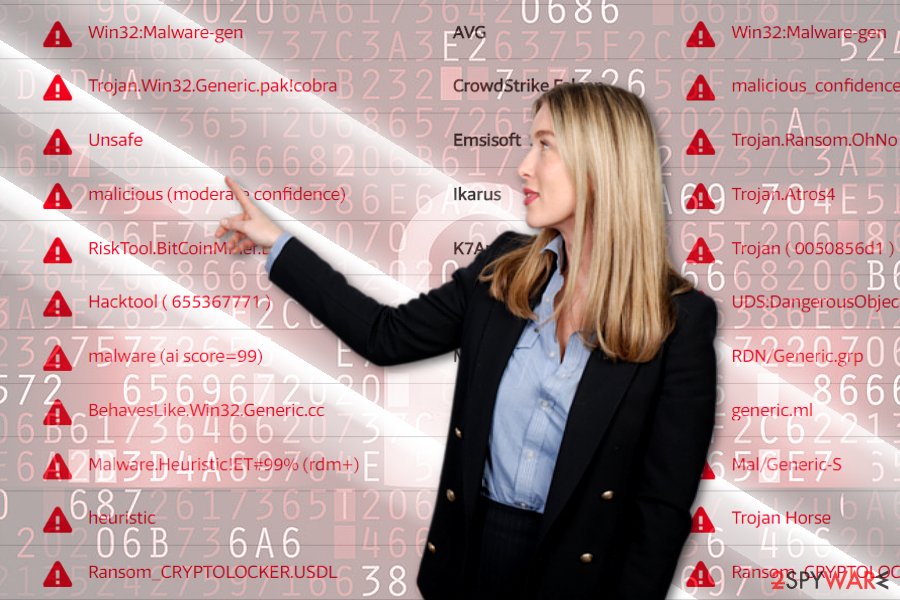OhNo! ransomware / virus (Removal Guide) - Free Instructions
OhNo! virus Removal Guide
What is OhNo! ransomware virus?
OhNo! ransomware is after your files

OhNo! virus operates as ransomware which is designed to encode files. Currently, it is still under development as not all samples of the malware encrypt data. Nonetheless, the virus appends .ohno file extension. It still manages to infiltrate systems and demands ransom. Here are the key features of the threat:
- functions via GoogleChrome.exe
- opens Mount Point Manager
- deletes certain files[1]
- asks ransom in XMR currency (Monero)
- detectable as Trojan.Ransom.OhNo, Trojan.Win32.Generic.pak!cobra, Ransom_CRYPTOLOCKER.USDL, etc
Though the virus does not function at its full power, remove OhNO! virus right away. FortectIntego or Malwarebytes will be helpful in this situation.
Misleading veneer?
While the virtual infection does not operate as a full-fledged malware yet, it surely contains the potential to become such. After the infiltration, OhNo! virus generates multiple system and shell processses[2], such as:
- kernel32.dll
- gdi32.dll
- ole32.dll
- shell32.dll
- msvcrt.dll
- comctl32.dll
Later on, it reads system registry files and further technical information about the system. It also launches Mount Point Manager and looks for other malware present on the system. Additionally, the malware connects to Local Procedure Call (LPC ) port. It may hide in [random number].rar older.
Naturally, due to its activity, the overall PC performance highly deteriorates. Such behavior lets us assume that the malware currently performs the role of data collector rather than attempts to inflict damage. Nonetheless, the crypto-malware also has a tendency to delete some files. After it completes its preparations, the error message called “OhNo!” pops up. Here is a short extract from it:
You have been infected with OhNo! ALL your Documents, Downloads, and Desktop have been Encrypted with a Unique Key to your System.(…) Please Pay 2.XMR to the specified address below and you will receive a Email with your Key.
Currently, the threat demands 2 XMR which approximately amounts to 276 USD. Since it is still under development, we discourage you from transmitting the money. Instead, focus on OhNo! removal.
Ways to get infected with a file-encrypting threat
Regarding the features of the malware, it tends to target systems with weak Remote Desktop Protocols (RDP). However, since it may also come into a system in .rar file, it suggests that spam emails are an additional distribution option.
You should not also exclude the possibility that the malware may dwell in a corrupted application. Thus, in order to lower the possibility of OhNo! malware hijack, make sure to update your security application, regularly scan the device and beware of the visited websites as well as downloaded software. 
Terminate OhNo! virus and delete its components
As most of ransomware threats, this threat also targets Windows. You should be able to remove OhNo! virus with the assistance of anti-virus and malware elimination utilities. However, due to the activity of the threat, it is not surprising if you will not be able to launch the tools.
If you encounter OhNo! removal problems, launch the operating system in Safe Mode, Further instructions are displayed below. Try to terminate its processes via Task Manager as well. Note that OhNo! ransomware targets non-native English speakers, such as Danish[3] users as well.
Getting rid of OhNo! virus. Follow these steps
Manual removal using Safe Mode
Reboot the system in Safe Mode and then launch an anti-malware tool to get rid of OhNo! malware. Since the malware may not encypt files, make haste to eradicate it.
Important! →
Manual removal guide might be too complicated for regular computer users. It requires advanced IT knowledge to be performed correctly (if vital system files are removed or damaged, it might result in full Windows compromise), and it also might take hours to complete. Therefore, we highly advise using the automatic method provided above instead.
Step 1. Access Safe Mode with Networking
Manual malware removal should be best performed in the Safe Mode environment.
Windows 7 / Vista / XP
- Click Start > Shutdown > Restart > OK.
- When your computer becomes active, start pressing F8 button (if that does not work, try F2, F12, Del, etc. – it all depends on your motherboard model) multiple times until you see the Advanced Boot Options window.
- Select Safe Mode with Networking from the list.

Windows 10 / Windows 8
- Right-click on Start button and select Settings.

- Scroll down to pick Update & Security.

- On the left side of the window, pick Recovery.
- Now scroll down to find Advanced Startup section.
- Click Restart now.

- Select Troubleshoot.

- Go to Advanced options.

- Select Startup Settings.

- Press Restart.
- Now press 5 or click 5) Enable Safe Mode with Networking.

Step 2. Shut down suspicious processes
Windows Task Manager is a useful tool that shows all the processes running in the background. If malware is running a process, you need to shut it down:
- Press Ctrl + Shift + Esc on your keyboard to open Windows Task Manager.
- Click on More details.

- Scroll down to Background processes section, and look for anything suspicious.
- Right-click and select Open file location.

- Go back to the process, right-click and pick End Task.

- Delete the contents of the malicious folder.
Step 3. Check program Startup
- Press Ctrl + Shift + Esc on your keyboard to open Windows Task Manager.
- Go to Startup tab.
- Right-click on the suspicious program and pick Disable.

Step 4. Delete virus files
Malware-related files can be found in various places within your computer. Here are instructions that could help you find them:
- Type in Disk Cleanup in Windows search and press Enter.

- Select the drive you want to clean (C: is your main drive by default and is likely to be the one that has malicious files in).
- Scroll through the Files to delete list and select the following:
Temporary Internet Files
Downloads
Recycle Bin
Temporary files - Pick Clean up system files.

- You can also look for other malicious files hidden in the following folders (type these entries in Windows Search and press Enter):
%AppData%
%LocalAppData%
%ProgramData%
%WinDir%
After you are finished, reboot the PC in normal mode.
Remove OhNo! using System Restore
-
Step 1: Reboot your computer to Safe Mode with Command Prompt
Windows 7 / Vista / XP- Click Start → Shutdown → Restart → OK.
- When your computer becomes active, start pressing F8 multiple times until you see the Advanced Boot Options window.
-
Select Command Prompt from the list

Windows 10 / Windows 8- Press the Power button at the Windows login screen. Now press and hold Shift, which is on your keyboard, and click Restart..
- Now select Troubleshoot → Advanced options → Startup Settings and finally press Restart.
-
Once your computer becomes active, select Enable Safe Mode with Command Prompt in Startup Settings window.

-
Step 2: Restore your system files and settings
-
Once the Command Prompt window shows up, enter cd restore and click Enter.

-
Now type rstrui.exe and press Enter again..

-
When a new window shows up, click Next and select your restore point that is prior the infiltration of OhNo!. After doing that, click Next.


-
Now click Yes to start system restore.

-
Once the Command Prompt window shows up, enter cd restore and click Enter.
Bonus: Recover your data
Guide which is presented above is supposed to help you remove OhNo! from your computer. To recover your encrypted files, we recommend using a detailed guide prepared by 2-spyware.com security experts.If your files are encrypted by OhNo!, you can use several methods to restore them:
The benefits of Data Recovery Pro
This tool is designed to help you restore damaged and lost files. It might come in handy recovering files affected by ransomware.
- Download Data Recovery Pro;
- Follow the steps of Data Recovery Setup and install the program on your computer;
- Launch it and scan your computer for files encrypted by OhNo! ransomware;
- Restore them.
The usefulness of Shadow Explorer
It is another alternative to restore encrypted data as the program uses volume shadow copies automatically generated by the operating system and, likewise, recreates the copies of the original files.
- Download Shadow Explorer (http://shadowexplorer.com/);
- Follow a Shadow Explorer Setup Wizard and install this application on your computer;
- Launch the program and go through the drop down menu on the top left corner to select the disk of your encrypted data. Check what folders are there;
- Right-click on the folder you want to restore and select “Export”. You can also select where you want it to be stored.
Finally, you should always think about the protection of crypto-ransomwares. In order to protect your computer from OhNo! and other ransomwares, use a reputable anti-spyware, such as FortectIntego, SpyHunter 5Combo Cleaner or Malwarebytes
How to prevent from getting ransomware
Stream videos without limitations, no matter where you are
There are multiple parties that could find out almost anything about you by checking your online activity. While this is highly unlikely, advertisers and tech companies are constantly tracking you online. The first step to privacy should be a secure browser that focuses on tracker reduction to a minimum.
Even if you employ a secure browser, you will not be able to access websites that are restricted due to local government laws or other reasons. In other words, you may not be able to stream Disney+ or US-based Netflix in some countries. To bypass these restrictions, you can employ a powerful Private Internet Access VPN, which provides dedicated servers for torrenting and streaming, not slowing you down in the process.
Data backups are important – recover your lost files
Ransomware is one of the biggest threats to personal data. Once it is executed on a machine, it launches a sophisticated encryption algorithm that locks all your files, although it does not destroy them. The most common misconception is that anti-malware software can return files to their previous states. This is not true, however, and data remains locked after the malicious payload is deleted.
While regular data backups are the only secure method to recover your files after a ransomware attack, tools such as Data Recovery Pro can also be effective and restore at least some of your lost data.
- ^ Leo. "OhNo!" Ransomware at 17/64, impersonates Google Chrome. Does not encrypt currently. Maybe in-dev.. Twitter. Online Source for Communication and News.
- ^ OhNo! ransomware. Payload Security. Free malware analysis service.
- ^ Eliminate computer viruses. Udenvirus. News and malware removal guides in Danish.





















